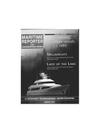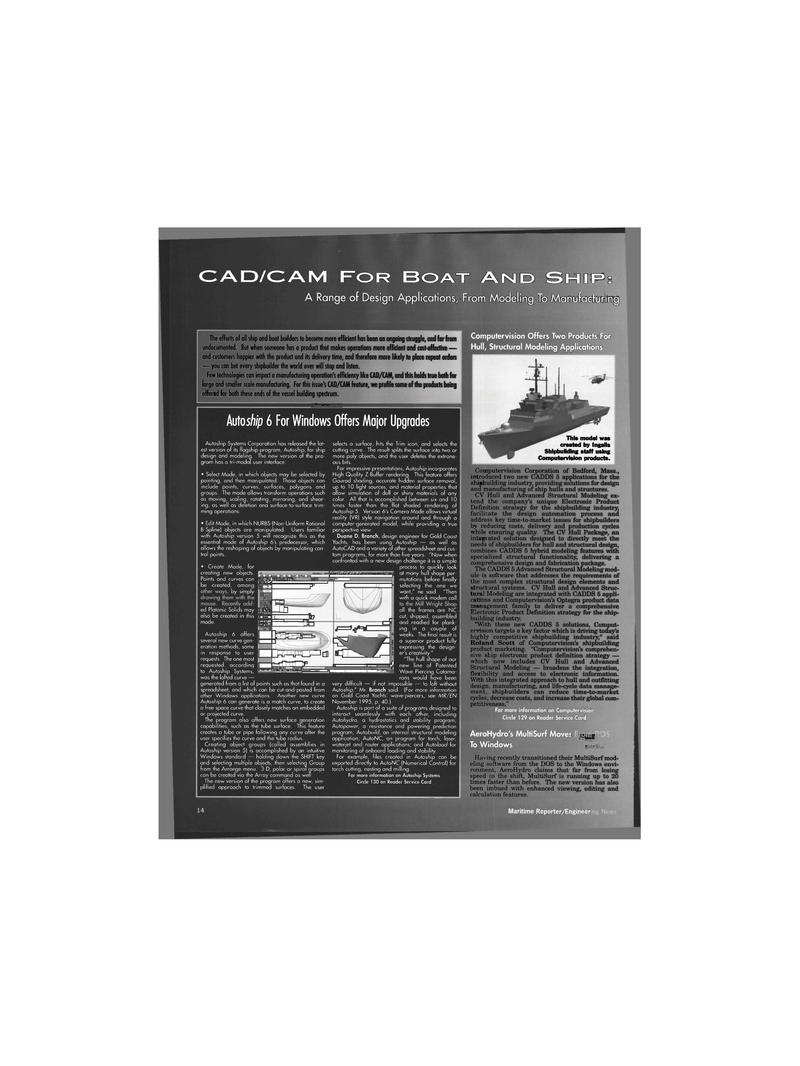
Page 12: of Maritime Reporter Magazine (January 1996)
Read this page in Pdf, Flash or Html5 edition of January 1996 Maritime Reporter Magazine
CAD/CAM FOR BOAT AND SHIP:
A Range of Design Applications, From Modeling To Manufacturing
The efforts of all ship and boat builders to become more efficient has been an ongoing struggle, and far from undocumented. But when someone has a product that makes operations more efficient and cost-effective — and customers happier with the product and its delivery time, and therefore more likely to place repeat orders — you can bet every shipbuilder the world over will stop and listen.
Few technologies can impact a manufacturing operation's efficiency like CAD/CAM, and this holds true both for large and smaller scale manufacturing. For this issue's CAD/CAM feature, we profile some of the products being offered for both these ends of the vessel building spectrum.
Computervision Offers Two Products For
Hull, Structural Modeling Applications
HHHHHHHfli
Auto ship 6 For Windows Offers Major Upgrades
Autoship Systems Corporation has released the lat- est version of its flagship program, Autoship, for ship design and modeling. The new version of the pro- gram has a tri-modal user interface: • Select Mode, in which objects may be selected by pointing, and then manipulated. Those objects can include points, curves, surfaces, polygons and groups. The mode allows transform operations such as moving, scaling, rotating, mirroring, and shear- ing, as well as deletion ana surface-to-surface trim- ming operations. • Edit Mode, in which NURBS (Non-Uniform Rational
B-Spline) objects are manipulated. Users familiar with Autoship version 5 will recognize this as the essential mode of Autoship 6's predecessor, which allows the reshaping of objects by manipulating con- trol points. • Create Mode, for creating new objects.
Points and curves can - ^^^^^^^^^^^^^ be created, among «' by simply ed Platonic Solids may ptc: EL& also be created in this .''. • mode. ^mammh'-^
Autoship 6 offers S'SS*S&V«*> - several new curve gen- g eration methods, some in response to user ^MjBaBjBaj^^Jj-; requests. The one most requested, accordinq swwrtSfeSa^?.' to Autoship Systems, ———— was the lofted curve — generated from a list of points such as that found in a spreadsheet, and which can be cut-and-pasted from other Windows applications. Another new curve
Auto ship 6 can generate is a match curve, to create a free space curve that closely matches an embedded or projected curve.
The program also offers new surface generation capabilities, such as the tube surface. This feature creates a tube or pipe following any curve after the user specifies the curve and the tube radius.
Creating object groups (called assemblies in
Auto ship version 5) is accomplished by an intuitive
Windows standard — holding down the SHIFT key and selecting multiple objects, then selecting Group from the Arrange menu. 3-D, polar or spiral groups can be created via the Array command as well.
The new version of the program offers a new, sim- plified approach to trimmed surfaces. The user selects a surface, hits the Trim icon, and selects the cutting curve. The result splits the surface into two or more poly objects, and the user deletes the extrane- ous bits.
For impressive presentations, Autoship incorporates
High Quality Z-Buffer rendering. This feature offers
Gourad shading, accurate hidden surface removal, up to 10 light sources, and material properties that allow simulation of dull or shiny materials of any color. All that is accomplished between six and 10 times faster than the flat shaded rendering of
Auto ship 5. Version 6's Camera Mode allows virtual reality (VR) style navigation around and through a computer-generated model, while providing a true perspective view.
Duane D. Branch, design engineer for Gold Coast
Yachts, has been using Auto ship — as well as
AutoCAD and a variety of other spreadsheet and cus- tom programs, for more than five years. "Now when confronted with a new design challenge it is a simple process to quickly look ^I at many hull shape per- mutations before finally • V selecting the one we want," ne said. "Then with a quick modem call all the frames are NC cut, shipped, assembled h I and readied for plank- .• ''.;•'""•'• ing in a couple of | weeks. The final result •j^^p " a superior product fully ^ I expressing the design- ':-V' ^^^ ^H I er's creativity." "The hull shape of our c » •I new line of Patented •••••••••^••KSl Wave Piercing Catama- rans would have been very difficult - if not impossible — to loft without
Auto ship," Mr. Branch said. (For more information on Gold Coast Yachts' wave-piercers, see MR/EN
November 1995, p. 40.)
Autoship is part of a suite of programs designed to interact seamlessly with each other, including
Autohydro, a hydrostatics and stability program;
Auto power, a resistance and powering prediction program; Auto build, an internal structural modeling application; AutoNC, an program for torch, laser, waterjet and router applications; and Autoload for monitoring of onboard loading and stability.
For example, files created in Autoship can be exported directly to AutoNC (Numerical Control) for torch cutting, nesting and milling.
For more information on Autoship Systems
Circle 130 on Reader Service Card
This model was created by Ingalls
Shipbuilding staff using
Computervision products.
Computervision Corporation of Bedford, Mass., introduced two new CADDS 5 applications for the shipbuilding industry, providing solutions for design and manufacturing of ship hulls and structures.
CV Hull and Advanced Structural Modeling ex- tend the company's unique Electronic Product
Definition strategy for the shipbuilding industry, facilitate the design automation process and address key time-to-market issues for shipbuilders by reducing costs, delivery and production cycles while ensuring quality. The CV Hull Package, an integrated solution designed to directly meet the needs of shipbuilders for hull and structural design, combines CADDS 5 hybrid modeling features with specialized structural functionality, delivering a comprehensive design and fabrication package.
The CADDS 5 Advanced Structural Modeling mod- ule is software that addresses the requirements of the most complex structural design elements and structural systems. CV Hull and Advanced Struc- tural Modeling are integrated with CADDS 5 appli- cations and Computervision's Optegra product data management family to deliver a comprehensive
Electronic Product Definition strategy for the ship- building industry. "With these new CADDS 5 solutions, Comput- ervision targets a key factor which is driving today's highly competitive shipbuilding industry," said
Roland Scott of Computervision's shipbuilding product marketing. "Computervision's comprehen- sive ship electronic product definition strategy — which now includes CV Hull and Advanced
Structural Modeling — broadens the integration, flexibility and access to electronic information.
With this integrated approach to hull and outfitting design, manufacturing, and life-cycle data manage- ment, shipbuilders can reduce time-to-market cycles, decrease costs, and increase their global com- petitiveness."
For more information on Computervision
Circle 129 on Reader Service Card
AeroHydro's MultiSurf Moves
To Windows mam m0MBm
Having recently transitioned their MultiSurf mod- eling software from the DOS to the Windows envi- ronment, AeroHydro claims that far from losing speed in the shift, MultiSurf is running up to 20 times faster than before. The new version has also been imbued with enhanced viewing, editing and calculation features.
Maritime Reporter/Engineer

 11
11

 13
13
